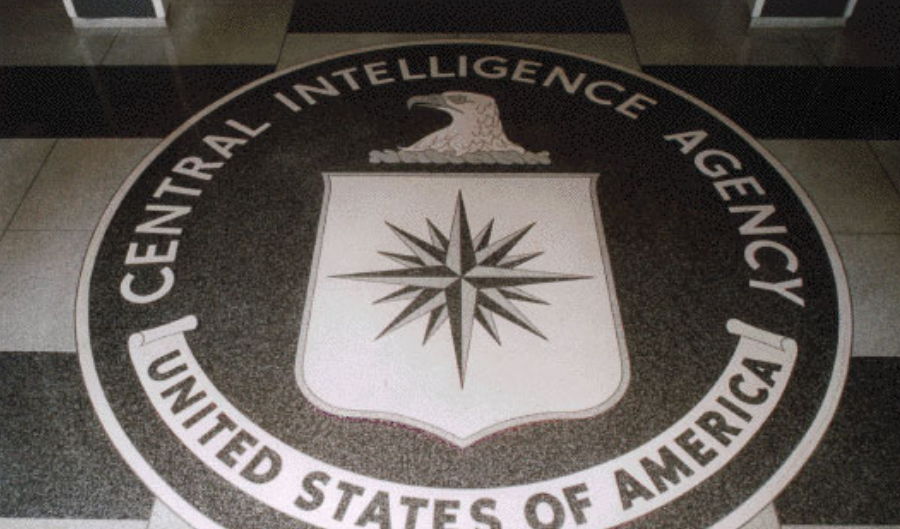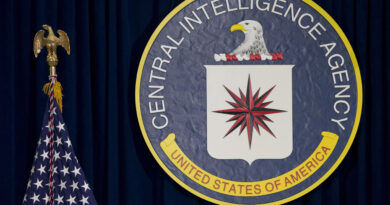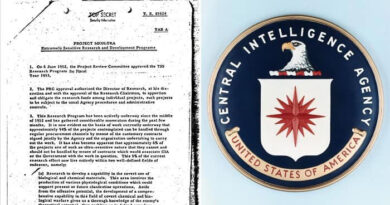MKULTRA and the CIA’s Battle on the Human Thoughts

(Review of Stephen Kinzer, Poisoner in Chief: Sidney Gottlieb and the CIA Search for Mind Control (New York: Henry Holt and Company, 2019))
The Central Intelligence Agency (CIA) has a fearsome reputation. The author and executor of countless coups and political assassinations, the CIA is notorious for waterboarding, “extraordinary rendition,” regime change, kidnapping, narcotics smuggling, financing of guerrilla wars, and many other unsavory activities around the world, including against Americans, even inside the United States.
But “fearsome” does not mean “flawless.” The CIA has failed at least as often as it has succeeded, and sometimes the failures are so flagrant—such as sending thousands of anticommunist guerrilla fighters behind enemy lines in Korea, Eastern Europe, China, and Southeast Asia during the Cold War, where nearly all of them died—that CIA insiders wryly refer to their organization as “Clowns In Action.”
Which is it? Is the CIA a dastardly menace or a hotbed of horrible mistakes? If Stephen Kinzer’s new book, Poisoner in Chief, is any indication, the answer is both.
A veteran reporter on foreign conflicts such as those in Rwanda, Guatemala, Nicaragua, and Iran, Kinzer is a former New York Times correspondent and, most famously, the author of the 2006 bestseller Overthrow: America’s Century of Regime Change from Hawaii to Iraq. In his latest effort he brings his analytical skills to bear on perhaps the most disturbing CIA project of them all: MKULTRA, the top-secret, long-running effort to find a method for controlling the human mind.
“History’s most systematic search for techniques of mind control,” Kinzer writes, was a by-product of World War II. At the end of 1942, a University of Wisconsin bacteriologist named Ira Baldwin—“America’s first bio-warrior” and a part-time Quaker preacher—was loaned to Washington (with the blessing of the University of Wisconsin president) in order to set up and run a bioweapons program for the United States military (p. 16). Based out of Camp Detrick in Maryland, the Baldwin lab cranked out bioweapons for possible use against Allied enemies. In one of Baldwin’s bigger projects, shipment of tons of anthrax spores, ordered by Winston Churchill for potential use against the Nazis, was approved by President Franklin D. Roosevelt and almost ready for delivery when the Germans surrendered on May 7, 1945 (p. 19).
For many, even for Quaker preachers, World War II cleared away the last of the psychological hurdles against unleashing bioweapons against an enemy. Kinzer’s book tells the tale of how the targeting of unsuspecting populations was later justified by the bigger war, the Cold War, which followed the demise of the Third Reich.
The ruined Third Reich provided much of the original brainpower for MKULTRA. Immediately after World War II, the CIA—formed out of the Office of War Information in 1945—was faced with a choice. The Germans and the Japanese had been conducting advanced experiments on germ warfare and other forms of biological weaponry. Should the Allies prosecute as war criminals the scientists involved with such projects, or hire them as expert advisors? With the Cold War starting and the Soviets looming as an unpredictable enemy, the CIA, with the tacit approval of the few members of the United States Congress who were allowed to know even the existence of the Central Intelligence Agency, decided to make use of the bioweapon expertise of erstwhile foes in order to counter the new adversary in Moscow.
For example, Kurt Blome, the Nazis’ director of biowarfare research and development whose work had been championed by Heinrich Himmler, was acquitted, by American political fiat, at the Doctors’ Trial in Nuremberg in 1947 and sent to work—as part of Operation Paperclip designed mainly to bring German rocket scientists to the US—at Camp Detrick (pp. 20–24).
It was at Camp Detrick that Blome encountered a rising star in the CIA, Sidney Gottlieb. Gottlieb, a bacteriological specialist who had been a star student of Ira Baldwin’s at Wisconsin, is the main figure in Kinzer’s book. His career is virtually synonymous with MKULTRA. Under the direction of Gottlieb, the CIA’s laboratories at Camp Detrick transitioned from R&D on bioweapons—often using unwitting American subjects, such as in 1950 when a US Navy minesweeper “specially equipped with large aerosol hoses” spent six days spraying the Serratia marcescens bacterium into the San Francisco fog, infecting some eight hundred thousand people (pp. 37–38)—to drugs which could be used for mind control. (MKNAOMI, MKULTRA’s sister CIA project, was also tasked with finding poisons and biotoxins which the CIA and the US government could use in various operations.) Gottlieb provided the big ideas into which to fit Blome’s nefarious knowledge of mass murder by bacillus. Gottlieb became, virtually overnight and with the help of former Nazi doctors, America’s “poisoner in chief.”
The CIA’s mind control program, which was assuming a bigger and bigger importance as fears of Soviet brainwashing grew in the US, was originally called Operation Bluebird and was personally overseen by CIA higher-up Allen Dulles. (47) At first, the Bluebird team experimented with “hypnosis, electroshock, and sensory deprivation,” along with drugs like sodium amytal, at CIA sites in “secret prisons in Germany and Japan,” looking for a way to extract information out of POWs and captured spies (pp. 44, 48–49). But Dulles was unsatisfied with the results and decided to give the young CIA recruit Sidney Gottlieb control of Bluebird’s updated iteration: Operation Artichoke (pp. 51–52). The goal of Artichoke was to do whatever it took to get prisoners to divulge military and state secrets to the CIA. The Cold War would brook nothing short of full-scale war against the human mind.
Dulles became deputy director of central intelligence three days after launching Artichoke in 1951, and Gottlieb, invisible to the outside world, was given virtually unlimited rein to carry out any experiments thought necessary to achieve mind control (p. 51). This drive to achieve total operational control over the human psyche eclipsed all reality and tactical limitation. If the US didn’t win the race to the mind control method, many in the CIA thought, the entire American population lay vulnerable to mental enslavement by the Soviets. Dulles, Kinzer writes, despite a disastrously unsuccessful three-year “Artichoke” attack on a Bulgarian political prisoner named Dmitri Dimitrov, “had convinced himself not only that mind control techniques exist but that Communists had discovered them, and that this posed a mortal threat to the rest of the world” (pp. 52–53).
Mind control was the pressing need, but nothing brought it within reach. Technique after technique, drug after drug, was tried on prisoners, but to no avail. In frustration, Artichoke agents under Gottlieb upped the ante, turning to marijuana, cocaine, and then heroin as possible catalysts of CIA-directed, anti-Soviet brainwashing. As part of Artichoke, a University of Rochester psychology professor was given a grant by the US Navy to test heroin on his students. The control of the mind remained as elusive as ever, despite the massive dosing of the Rochester student population with opiates. Nothing seemed to have the potential to crack open the mind for the CIA (p. 59).
Someone in Artichoke suggested using mescaline after the other narcotics failed, and this gave Sidney Gottlieb an idea. He remembered hearing about a drug called LSD which Dr. Albert Hofmann had discovered during an experiment at Sandoz laboratories in Basel, Switzerland, in 1943. Lysergic acid diethylamide (LSD), an ergot enzyme, produced extraordinary and disturbing psychological effects, Dr. Hofmann found when he ingested some and recorded the drug’s effects. Washington learned of Hofmann’s discovery in 1949, and one of the chemical specialists in the US military complex told Gottlieb of the new substance (pp. 34–35) In 1951, Gottlieb asked Harold Abramson, who had been a physician in the Chemical Warfare Service during World War II, to administer LSD to him. Gottlieb experienced the same psychedelic state as Dr. Hofmann had described. Other subjects were tested, as well, not all of them wittingly, and all seemed to exhibit similar reactions. LSD most definitely altered the mind (pp. 60–61). Gottlieb was convinced that he had found the magical drug which would allow the CIA to control the psyche, and therefore to beat the Soviets at (what Allen Dulles, Gottlieb, and many others at CIA thought, at least, was) the Soviets’ own game.
The experiments on human subjects followed rapidly after Gottlieb’s conversion to belief in the powers of LSD. These experiments often ended in death, often by murder. One study quoted by Kinzer reports that
in 1951 a team of CIA scientists led by Dr. Gottlieb flew to Tokyo….Four Japanese suspected of working for the Russians were secretly brought to a location where the CIA doctors injected them with a variety of depressants and stimulants….Under relentless questioning, they confessed to working for the Russians. They were taken out into Tokyo Bay, shot and dumped overboard. (p. 64)
The CIA carried out similar experimentation and executions in Korea and Germany (p. 64). Gottlieb was usually personally involved.
Throughout the 1950s the experimentation continued. An American artist named Stanley Glickman was lured to a bar near his studio in Paris by CIA agents in 1951 and a chemical was slipped into his drink. Glickman began to hallucinate wildly. He fled in a state of panic and remained in his Paris apartment for the next ten months in paranoid hiding until his family came to take him home, and then he spent the rest of his life as a near invalid. The chemical which the CIA had slipped into Glickman’s drink was almost certainly LSD, and Glickman, Kinzer suggests, had been chosen by the CIA because he had just recovered from hepatitis and the Artichoke team was conducting an experiment on the effects of hepatic infection on the efficacy of LSD (pp. 66–67)
Things got worse from there. In 1952, the CIA commissioned underworld denizen and former vice cop George Hunter White to run a human-subjects experiment site at 81 Bedford Street in Greenwich Village, New York (pp. 74–75). White’s job was to bring to the CIA’s apartment “expendables” on whom Gottlieb and his team could test LSD. White “knew the whores, the pimps, the people who brought in the drugs,” as one of Gottlieb’s MKULTRA colleagues later explained, and this made him invaluable for procuring the “drug users, petty criminals, and others who could be relied upon not to complain about what had happened to them” when the CIA’s experiments were finished (pp. 76–77). Many of these “expendables” suffered nervous breakdowns, and some died.
In order to keep the supply of LSD flowing, CIA agents went to Basel, where LSD had been discovered, and tried to buy all the LSD in stock. Allen Dulles authorized a $240,000 outlay to pay for it (p. 86). Sandoz held the patent for Hofmann’s 1943 discovery, but Sandoz wanted nothing to do with the troublesome substance and so Gottlieb, freed of any need to scruple over IP infringement, tasked US pharmaceutical company Eli Lilly with making LSD in the States (pp. 85–86) With their mind control serum in production, MKULTRA agents could focus on how to dose experimental subjects. The CIA even hired a professional magician, John Mulholland, to teach Gottlieb and his agents how to deliver LSD into unsuspecting subjects’ drinks and food without being detected (pp. 89–94)
Gottlieb recruited a Kentucky addiction specialist, Dr. Harry Isbell, to test LSD and new mind-altering drugs on prisoners and patients. More lives were destroyed (pp. 94–96). Among the victims of another of Gottlieb’s agent-doctors was none other than James “Whitey” Bulger, the mafioso who, along with “nineteen other inmates” at the Atlanta Federal Penitentiary, beginning in 1957 “was given LSD nearly every day for fifteen months, without being told what it was” (pp. 98–99). Bulger was plagued for the rest of his life with nightmares, suicidal thoughts, and “deep depression” (p. 98). Bulger, who had been told that he was taking part in experiments designed to find a cure for schizophrenia, did not learn the truth about what had happened until 1979 (pp. 263–64).
The human toll of Gottlieb’s MKULTRA experiments continued to mount. One of Gottlieb’s closest associates in the project, Frank Olson—a bacteriologist trained at the University of Wisconsin who had also been recruited for the CIA by Gottlieb’s mentor Ira Baldwin—began to express doubts about what the MKULTRA team was doing. He told his wife that he had made a “terrible mistake” in his work (p. 114). He shared his misgivings with his CIA colleagues as well. Olson’s conscience appeared to be getting the better of him, and he became a liability to the team.
In late 1953, Gottlieb surreptitiously dosed Olson with LSD at a backwoods MKULTRA gathering, “Deep Creek Rendezvous,” outside Camp Detrick (p. 113). Olson spiraled into a frightening disorientation, and early in the morning on November 28, 1953—a few days after Thanksgiving—Olson “fell or jumped” from a window of the Statler Hotel in Manhattan, dying few moments after hitting the concrete below. Another MKULTRA agent, Gottlieb’s lieutenant Robert Lashbrook, was the only other person in the room when Olson “fell or jumped” (pp. 120–21). Lashbrook told the New York City police that Olson had jumped out of the window and Olson’s death was originally designated a suicide, but the Olson family eventually grew suspicious and an investigation was carried out, including a new autopsy on Olson’s body. The forensic pathologist, after a month’s examination of the corpse, declared: “I think Frank Olson was intentionally, deliberately, with malice aforethought, thrown out of that window” (p. 250). Wounds on Olson’s body were consistent with methods taught in CIA manuals for incapacitating people and then killing them in order to make their deaths look self-inflicted.
Gottlieb and MKULTRA were shaken by Olson’s demise, but they carried on with their work. They spent the next few years looking for magic mushrooms in Mexico (157); arranging suicide capsules for American agents, including U-2 pilot Gary Powers (who chose not to use his when he was shot down over the Soviet Union) (pp. 172–75); attempting, at the order of then attorney general Robert Kennedy, to assassinate Cuban dictator Fidel Castro (after exploding cigars and exploding conch shells were ruled out, Gottlieb tried with a wetsuit laced with fungi and bacteria) (p. 184); and hooking Allen Ginsberg and other radicals on LSD (pp. 188–90). Gottlieb personally delivered to the American embassy in Leopoldville in the Congo poisons that Gottlieb had developed to assassinate Prime Minister Patrice Lumumba, but the Belgians and the Africans beat the CIA to it (pp. 176–80).
Gottlieb’s career brought ruin and suffering to untold numbers of people, many of them innocent. He retired from the CIA in 1973 after receiving the Distinguished Intelligence Medal (p. 211). Lifelong devotees of folk dance, Gottlieb and his wife, Margaret, moved to the countryside in rural Virginia and attempted to blend in with the small community there, volunteering, dancing, and experimenting with radical ecology. However, “investigative reporter Seymour Hersh, who had won a Pulitzer Prize for exposing the My Lai massacre in Vietnam,” learned of the MH-CHAOS program targeting Americans, and the Congress was forced to act. Gottlieb’s career, long a well-kept secret, was being brought into the open, and his retirement would therefore be far from peaceful.
But there were still many who tried to cover up what Gottlieb and the other MKULTRA agents had done. In 1975, after the outcry caused by the Hersh reporting, President Gerald Ford deputized Vice President Nelson Rockefeller to chair a commission on the CIA. The new CIA director, William Colby, was remarkably frank. Colby informed the Rockefeller Commission that “the CIA had conducted LSD experiments that resulted in deaths. Later he referred to assassination plots” (p. 216). Nelson Rockefeller, attempting to prevent the CIA director from revealing too much, buttonholed Colby later: “Bill, do you really have to present all this material to us?” (p. 216).
In 1977, in the wake of the Church Report on further American intelligence excesses, Senator Edward Kennedy, Robert’s brother, spurred on by some documents which had been discovered as the result of a FOIA request (Gottlieb had ordered all MKULTRA files burned, but some undetected copies remained), called Admiral Stansfield Turner to testify before Congress on MKULTRA. The walls were closing in. Gottlieb himself was eventually forced to testify—albeit in a closed-room setting his lawyer had helped arrange—but Gottlieb essentially pleaded amnesia (nearly all of his answers to questions about MKULTRA were some version of “I do not recall”) and the matter seemed to end there.
Still, the skeletons in Gottlieb’s closet would not go away. In 1984 Gottlieb agreed to meet with the family of Frank Olson, the former MKULTRA colleague who had “fallen or jumped” from his Manhattan hotel room in 1953. Eric Olson, Frank Olson’s son, was unconvinced by Gottlieb’s explanation for the “accident,” and, after Frank Olson’s widow and Eric’s mother passed away, ordered Frank’s body exhumed in 1994. As information about MKULTRA built in the public’s awareness, other cases were reopened, including that of Stanley Glickman. (257) The courts were now involved and Gottlieb could not count on the CIA to get him out of his legal trouble. Gottlieb pushed back the trial for Glickman’s murder as long as he could, and then, in early March, 1999, Sidney Gottlieb died.
Like Frank Olson, it was not officially revealed whether or not the death had been a suicide (p. 259).
Stephen Kinzer’s Poisoner in Chief is a highly readable, thoroughly researched introduction to the life and work of one of America’s most unknown, and yet infamous, government agents. Kinzer is to be thanked for his plainspoken, courageous book. Even those who have studied the CIA and the various schemes and crimes which “the Agency” has committed over the past seventy-five years will be surprised by some of the information Kinzer relates. To see in one volume a rendering of just some of the lives ruined by just one CIA program, MKULTRA, is a sobering revelation.
Sidney Gottlieb, the person directly responsible for much, if not most, of the MKULTRA devastation over more than twenty years, remains as mysterious at the end of Kinzer’s volume as at the beginning, however. By all accounts Gottlieb was a good student from a stable family. Kinzer speculates that perhaps Gottlieb’s having been rejected for military service in World War II—Gottlieb stuttered and had a clubfoot—left him unsatisfied and impatient to prove his patriotism, an urgent task for the son of immigrant Jews (p. 50). Gottlieb was heavily involved in New Age mysticism and meditation and appears to have expended considerable energy psychologically compartmentalizing his “work,” so there are indications that he was aware that the experiments he and his MKULTRA team were carrying out were, at best, unethical, and objectively speaking often outright crimes.
But Gottlieb was hardly alone in his endeavors, and the explanation that Gottlieb, Allen Dulles, and many others in the CIA gave—to themselves and to each other, and to the world around when pressed—makes the most sense. They had a country to defend, they faced an enemy of unprecedented cruelty in the Soviet Union, and they were willing to do whatever it took, even sacrificing innocent people, to keep Americans as a whole from falling under the spell of communist mind control.
*** This article has been archived for your research. The original version from The Shepherd of the Hills Gazette can be found here ***


